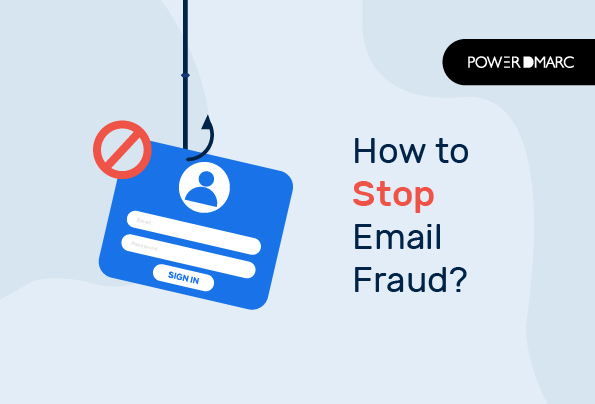Email is one of the most widely used forms of communication today, with billions of emails sent every day. Unfortunately, it is also a prime target for cybercriminals looking to perpetrate email fraud. Email fraud can take many forms, such as phishing attacks, business email compromise (BEC), and email spoofing. These types of attacks can lead to financial loss, data theft, and damage to an individual’s or organization’s reputation. In this blog, we will discuss email authentication and other methods and best practices that can help prevent email fraud.
What is Email Fraud?
Email fraud refers to any scam that uses email to deceive or trick victims into providing sensitive information or making financial transactions.
Email fraud can take various forms, including phishing attacks, business email compromise (BEC), email spoofing, and more. Below, we will discuss some of the most common types of email fraud in more detail.
Phishing Attacks
Phishing attacks involve sending fraudulent emails that appear to be from legitimate sources, such as banks, e-commerce websites, or social media platforms. The goal of these emails is to trick the recipient into providing sensitive information, such as login credentials, credit card numbers, or other personal information. Phishing emails often contain urgent or threatening language to create a sense of urgency, encouraging the recipient to act quickly without thinking.
Business Email Compromise (BEC)
BEC, also known as CEO fraud, involves impersonating a high-level executive within an organization to trick employees into transferring funds or providing sensitive information. BEC scams often target finance or HR personnel and are designed to bypass normal procedures, often by creating a sense of urgency or making the request appear as if it comes from a trusted source.
Email Spoofing
Email spoofing involves sending emails with a forged sender address in an attempt to trick the recipient into believing the email is from a legitimate source. Spoofed emails can be used to launch phishing attacks, BEC scams, or malware distribution campaigns. Spoofed emails are often designed to look like they are from well-known companies or organizations to increase the chances of the recipient falling for the scam.
Ransomware/Malware Distribution
Ransomware / Malware distribution is another form of email fraud that involves sending emails with attachments or links that contain malware. These emails often contain a sense of urgency, urging the recipient to open the attachment or click the link immediately. Once the attachment is opened or the link is clicked, the malware can infect the recipient’s computer or device, giving the attacker access to sensitive data or control over the device.
Email fraud can have serious consequences, including financial loss, identity theft, and damage to an individual’s or organization’s reputation. It is important to remain vigilant and take steps to protect yourself and your organization from email fraud.
Stop Email Fraud with Email Authentication
Email authentication is the process of verifying the identity of the sender of an email message. This process is critical in preventing email fraud because it ensures that the recipient can trust that the email is indeed from the person or organization that it claims to be from. There are several email authentication protocols that are widely used, including Sender Policy Framework (SPF), DomainKeys Identified Mail (DKIM), and Domain-based Message Authentication, Reporting & Conformance (DMARC).
SPF is a protocol that allows the owner of a domain to specify which mail servers are authorized to send emails on behalf of that domain. DKIM adds a digital signature to an email message that can be used to verify its authenticity. DMARC is a policy framework that provides guidance to email receivers on how to handle messages that fail authentication checks.
Other Methods to Stop Email Fraud
Besides email authentication, there are other methods and best practices that can help prevent email fraud. One of the most effective is to train employees and educate them on how to identify and avoid email fraud. This training should include information on how to identify phishing emails, how to spot suspicious emails, and how to verify the authenticity of an email.
Another effective method is to use email filters and firewalls to block suspicious emails from reaching their intended recipients. Email filters can be configured to block emails that contain certain keywords or phrases, while firewalls can block emails from known malicious sources.
Best Practices to Stop Email Fraud
In addition to the methods discussed above, there are several best practices that individuals and organizations can follow to help prevent email fraud. These include:
- Always verify the authenticity of an email before responding or clicking on any links.
- Use strong passwords and two-factor authentication to protect email accounts.
- Keep email software and antivirus software up-to-date.
- Be cautious of emails that contain urgent requests, offer prizes, or ask for personal or sensitive information.
- Use encryption when sending sensitive or confidential information via email.
Conclusion
Email fraud is a serious threat that can lead to financial loss, data theft, and reputational damage. However, by implementing email authentication protocols, training employees, using email filters and firewalls, and following best practices, individuals and organizations can significantly reduce the risk of falling victim to email fraud. It is important to remain vigilant and stay up-to-date with the latest trends and techniques used by cybercriminals to perpetrate email fraud.
- Can Blockchain Help Improve Email Security? - May 9, 2024
- Datacenter Proxies: Unveiling the Workhorse of the Proxy World - May 7, 2024
- Kimsuky Exploits DMARC “None” Policies in Recent Phishing Attacks - May 6, 2024
